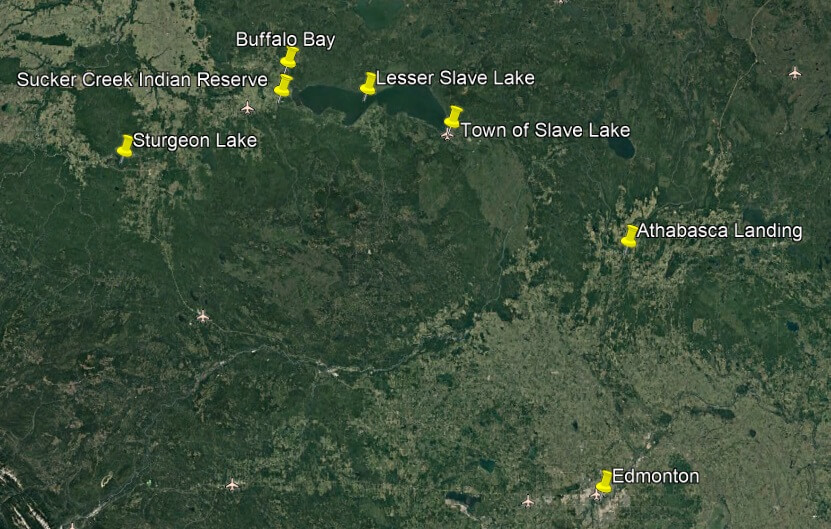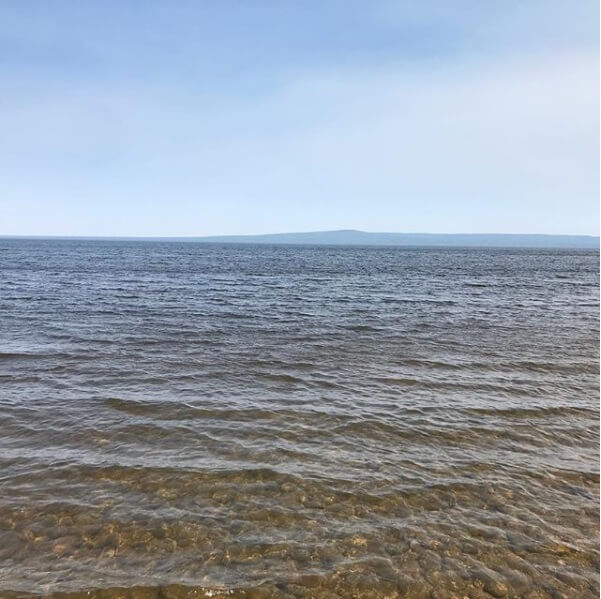The Dream that Solved a Murder
Canadian frontier lore is littered with strange tales of clairvoyance. In these stories, certain gifted people supposedly become aware of distant events through visions or dreams. More often than not, the gifted characters in these stories are of aboriginal (often Dene) descent.

One such tale to come out of Grande Prairie Country in Northwest Alberta, for example, tells of a strange dream had by a Beaver Indian woman in the summer of 1945. In her dream, the ghost of her dead husband led her to the bodies of two fellow tribesmen who drowned in the Wapiti River about a month earlier. Accompanied by the widow of one of the dead men, the woman used the instructions from her dream to locate the bodies, which were then given a proper burial.
Other tales of clairvoyance on the Canadian frontier involve Indian medicine men. For example, in two different stories from Northern Canada, native shamans made accurate predictions regarding the fate of ships which had not arrived on schedule. One of these events took place in Southeastern Yukon in the spring of 1908, while the other occurred in Churchill, Manitoba, sometime in the early ‘40’s.
Interestingly, one of the most dramatic tales of ‘Second Sight’ (as the gift of clairvoyance is sometimes called) in Canada was not experienced by a native, nor did it take place in the Great White North itself. This story involved an Englishman named George Hayward, who had an amazing extrasensory experience somewhere in Great Britain involving his brother in Canada, more than 4,000 miles away.

George Hayward’s Dream
On the witching hour of September 18, 1904, George Hayward woke up in his English home in a cold sweat. With fumbling fingers, he lit up a candle, produced a paper and pencil, and wrote down the details of the disturbing nightmare from which he had awakened. He made sure to record as much of the dream as he could remember, down to the grisly minutia; something deep inside him told him that this was important.
The dream had been stunningly vivid. Some mysterious force had dragged him from a hazy reverie into a wild world of raging rivers and gloomy pine forests. The air was fragrant with the smell of pine resin, the tang of tanned buckskins, and the smoke of a proximate campfire. Nearby stood a cluster of Indian teepees. Their smoke-stained tops, bristling with lodge poles, cast black silhouettes against the evening sky.

Suddenly, two white men rode past the Indian village and stopped by the side of a slough. They tethered their horses to a nearby tree and rolled out their woolen blankets. In the light of the moon, George saw that one of the partners- a tall man with a black beard- was his brother, Edward.

As the two men set up camp, an Indian woman carrying a woven basket made her way towards them. Just as she prepared to announce her presence, the two white men began to argue. Frightened, the woman slipped back into the darkness. No sooner had she left than the argument quickly escalated into a ferocious quarrel. Eventually, the shorter of the two men seized a rifle and shot Edward dead.

George watched in horror as the murderer built a bonfire, heaved his brother’s body onto the pyre, and threw some of the dead man’s belongings into the slough.

Staff Sergeant Anderson
Several days later, in the wilds of Northwestern Canada half a world away from George Hayward and his English bed, Staff Sergeant Kristjan Fjelsted Anderson of the Royal North West Mounted Police headed out on patrol.

Staff Sergeant Anderson was a large, friendly, rugged-looking Icelander. He had ice-blue eyes, a thick brown mustache, and the stubborn tenacity of a Norseman. In Lesser Slave Lake Country, in North-Central Alberta, he was the law, and as Hollywood Northwesterns fondly said of his breed, he “always got his man”.
That morning, Anderson headed towards the Sucker Creek Indian Reserve on the shores of Lesser Slave Lake. Back in 1899, he had played a role in the signing of Treaty 8- an agreement between the British Crown and the local natives which led to the establishment of this Reserve.

While guiding his horse down the winding trail to the Cree settlement, perhaps reflecting on the great changes that had taken place in the region since the signing of the Treaty, Anderson was approached by Mistoos, the chief of the Sucker Creek First Nation. In a hushed voice, Mistoos told the Mountie a tale of mystery and intrigue.
Mistoos’ Tale
Several days earlier, the chief said, two white prospectors had camped beside the Reserve. One of them was a tall, black-bearded man whom Mistoos maintained was a “Shagonash”, or “Englishman”. His shorter partner, who walked with a slight limp, was called Charlie.
Two days after their arrival, Charlie rode off with all the horses. His black-bearded partner was nowhere to be seen. Curiously, the two men had made an enormous bonfire the night of the Shagonash’s disappearance- a strange thing to do, as the night was quite pleasant. This peculiarity became ominous when Mistoos’ cattle, bawling anxiously, pawed the ashes of this bonfire as though they scented blood.

Anderson thanked the Indian for the information and continued on his patrol. Early the following morning, he rode into the Sucker Creek Reserve and entered Mistoos’ teepee, determined to get to the bottom of this little mystery. The chief greeted him and introduced him to two boys named Napasise and Moonais, who had paid a visit to the white men several days earlier.
“The white men gave us things to eat,” one of the boys told Anderson. Grinning, the young Crees described how the Shagonash had sewed leather over the stock of his gun, as if he thought it might make it shoot straighter. He did this with a strange implement- a fingerless leather glove with a big needle fitted into the palm.
The Englishman also wore a big shining buckle on his belt, and was followed everywhere by a yellow dog who seemed to love his master. The morning after the Englishman disappeared, Charlie had to physically drag the dog away from the campsite; for some reason, it did not want to leave.
The Campsite
After interviewing the boys, Anderson followed Mistoos to the site of the prospectors’ camp.
“Plenty ashes, eh?” the chief said, gesturing towards the remains of the white men’s campfire. Indeed, the prospectors had built a tremendous fire for such a mild night.

Anderson got on his knees and sifted through the ashes with his hands. He quickly unearthed several charred fragments of bone. ‘They might be from a moose,’ the Mountie thought to himself. ‘You can’t believe all the talk you hear amongst the teepees.’ Nevertheless, he slipped the bones into the pocket of his red serge, determined to have them examined by a Force physician.
Not far from the campfire was a slough, from which the white men had evidently got their water. On a hunch, Anderson slipped off his boots, rolled up his yellow-striped breeches, and waded into the swamp barefoot, feeling the soggy bottom with his toes for anything out of the ordinary. In no time, Mistoos assisted the Mountie by dragging the slough with a rake. Soon, the chief fished out a battered kettle.
“Dat’s it!” exclaimed one of the young Cree boys, who had come to watch the men search. “Dat’s de kettle de white men used.”
That accomplished, Anderson made one last scan of the campsite. This time, he noticed a pair of slender moccasin prints, only a few days old, leading from the teepees to the camp and back again. ‘Perhaps,’ the Staff Sergeant mused, ‘the Indians knew more about the disappearance of the Shagonash than they were prepared to tell.’
Charlie King
Just as he was about to leave, some instinct caused the Scandinavian to glance up at the forest wall. For a moment, he caught a glimpse of sinewy fingers resting on a tree branch and a pair of dark eyes peering at him from out of the shadows. In a heartbeat, Anderson’s mysterious observer vanished noiselessly into the brush. The Mountie shrugged his shoulders and trudged back to the Reserve, where he had left his horse.
Before leaving the Reserve, Anderson decided to pay a visit to Moise Gladu, a French-Cree Metis hunter who lived in a nearby cabin. While the Metis set about preparing a pot of tea, the Icelander made a quick inventory of his home. The place was filled with fox traps and a single clunky bear trap.

“Figure on going trapping?” the Mountie asked.
“Non, Monsieur,” the Metis replied. “Dem traps, dey belong to Charlie King. He’s come from Edmonton. Now he’s figure on going back by de steamer and wants for sell dem.”
No sooner had Gladu spoken than a pleasant-faced man with a trail-worn Stetson limped into the cabin. “Howdy,” the stranger said to the Mountie, touching the brim of his hat. “Charlie King, at your service.”
Anderson informed King that he was investigating the disappearance of his partner and asked him if he could shed some light on the situation. In a friendly, matter-of-fact tone, the prospector described his trip from Edmonton. After that, he related how he had met a stranger, who called himself Leaman, in the nearby sandhills. They camped together beside the Reserve. Several days later, Leaman set out on foot for Sturgeon Lake to the southwest, hoping to do some prospecting there. The man had asked King to take care of his horses for him while he was away.
The Arrest
Anderson thanked King for the information and returned to the Mounted Police barracks at Buffalo Bay, a body of water northwest of Lesser Slave Lake. There, he told his subordinate about his brush with Charlie King, and of the prospector’s account of his partner’s disappearance. “Better saddle up,” he told the Constable, “and leave for Sturgeon Lake. Search every Indian stopping-place and speak to everyone you meet on the trail. Report back here as quick as you can.”

The young Mountie did as ordered. A week later, he returned to the barracks, dust-stained and travel-weary. He informed Anderson that, although he had interviewed every living soul on the trail to Sturgeon Lake, no one had seen a man matching the description of the missing prospector.
That did it. Through the Hudson’s Bay Company outpost at the southeastern end of Lesser Slave Lake, Anderson secured a warrant for Charlie King’s arrest. He found the prospector waiting with his luggage on the shores of the great lake, about to embark on the S.S. Midnight Sun. Had the steamer arrived before Anderson, King would have made his way down the Lesser Slave and Athabasca Rivers to Athabasca Landing. Instead, Anderson hauled him to the nearby RNWMP jail, much to the outrage of local trappers, who were sure of King’s innocence.

Ignoring King’s own protestations, Anderson tracked down the prospector’s belongings. Soon, the barracks’ shed was piled with 40 fox traps, a huge bear trap, and a number of pack saddles. The stables, on the other hand, housed four of King’s horses, each of them bearing a Diamond C brand.
Evidence
Following the arrest, Anderson returned to the Sucker Creek Reserve and began sifting through the ashes of the white men’s campfire with a window screen. Soon, he uncovered more shards of charred bone, a waistcoat buckle, and a broken half of a large needle.
The local Cree, in the meantime, dragged the slough. In no time, they produced a pair of soggy boots. Inside one of the boots was a bundle containing a tie pin surmounted by a gold nugget, a pocket watch with a broken chain, and a round sovereign case- a sterling silver wallet designed to carry British sovereign coins. Also in the bundle was an empty cartridge shell- perhaps evidence of a murder.

Amongst some of the muck brought up from the bog, Anderson spied something glinting in the sun. This proved to be a thin piece of broken steel. The Mountie placed this artifact beside the needle recovered from the ashes, and saw that they fit together perfectly. This discovery linked the items from the slough with the bones from the fire.
Anderson had a hunch that additional clues lay at the bottom of the swamp. Using his own money, he hired the local Cree to drain the mire and dredge it thoroughly. After a few days, the operation was complete. In addition to the boots and the soggy bundle they contained, the slough yielded one last significant artifact- a large square of tarnished silver. A local Metis named Cashir Cardinal recognized this item as the buckle from the belt of the missing Shagonash.
Clues
While Kristjan Anderson searched for evidence in the campsite beside the Sucker Creek Reserve, Constable Lowe transported Charlie King to Edmonton. There, he delivered the murder suspect into the hands of Inspector D’Arcy Strickland, a big beefy Mountie with a jovial disposition. Strickland, in turn, had King transferred to the Royal North West Mounted Police jail at nearby Fort Saskatchewan, to the northeast.
That accomplished, Lowe searched Edmonton for clues of King’s movements prior to his trip north. Finally, in a saddler’s shop on Kinistino Avenue (now 96th Street), he found a man mending a pair of harness straps with a curious device- a fingerless leather glove with a needle fitted into the palm.

“What’s that thing?” the Mountie asked the saddler casually, recalling the implement with which King’s partner sewed leather onto his gunstock, according to the Cree boys.
Grinning, the tradesman explained that the device was called a ‘sewing palm’, and that he learned to use when he worked as a sailor. In those days, he used it to mend canvas sails.
“Sell many of them?” Lowe asked.
“No!” the saddler replied. “Last one I sold was in August to some guy going up Peace River way. He stuck around a couple of days sewing canvas panniers for his pack-horses.”
Convinced that he had finally picked up his quarry’s trail, Constable Lowe then paid a visit to the local Brands Inspector. The Inspector informed him that no ‘Diamond C’ brand was registered in either Saskatchewan or Alberta. ‘In that case,’ the Mountie thought disappointedly, ‘King’s horses must have come across the United States border.’
More Clues
Following that setback, Lowe visited the local Hudson’s Bay Company retail store- a sad relic of a bygone era in which the HBC’s Fort Edmonton served as the capital of Canada’s Wild West. There, a grizzled trader recalled selling a huge bear trap- the same clumsy piece of metal from Moise Gladu’s shack- to a black-bearded Englishman the previous summer.
“Ah, here we are!” the trader said, pointing his finger at a line in the store blotter. “August 14th, Edward Hayward- 10 yards of canvas; 40 fox traps; a list of grub; and one bear trap! He paid by cheque. In fact, I think I’ve got his cheque right here.”
After rummaging around for a bit, trader produced a cancelled cheque for $200.00, issued by the Bank of Montreal in Nelson, BC. The cheque was signed “Edward Hayward”.
Constable Lowe removed his campaign hat to scratch his head. Didn’t Charlie King say that his partner’s name was Leaman?
The Victim

Lowe found what he believed might be the answer to this question at the Edmonton Hotel. There, on the August 14th register, were two names, one below the other: Charles King and Edward Hayward. Donald Ross, the hotel manager, informed him that the men’s trunks were stored in the basement.
Using Charlie King’s keys, which the Mounties had taken from the suspect before jailing him, Constable Lowe opened the trunk marked “C.K.”, only to find some old clothes, a few letters from Salt Lake City, Utah, and a railroad ticket from Fort Macleod to Edmonton inside.
Interestingly, another key on King’s keychain unlocked the second trunk, belonging to one ‘Edward Hayward’. Inside were some papers indicating that Hayward had worked as a sailor, a letter from Edward’s brother George, and a receipt for a railway ticket from Calgary to Edmonton with the same date as King’s ticket stub.
Constable Lowe reported his findings to Inspector D’Arcy Strickland. Strickland, in turn, sent a letter to Edward’s brother George, in England, inquiring as to whether he had information regarding his brother’s whereabouts.
Luck seemed to be with the Mounties when a livery man, through the Brands Inspector in Edmonton, informed Constable Lowe that he had sold four horses with a ‘Diamond C’ brand to an Englishman named Hayward the previous August. This success was tempered by a report from Salt Lake City that Charlie King, the murder suspect, was a hard-working farmer without a stain to his character.
Confirmation
Constable Lowe returned to Lesser Slave Lake and reported his findings to Staff Sergeant Anderson. The Icelander immediately struck out south for Nelson, British Columbia, from which Edward Hayward’s cheque had originated. Posing as a lumberjack, he tracked down members of a logging crew on which Hayward had worked. The mackinaw-clad woodcutters remembered that Hayward had worn a gold nugget tiepin and a silver belt buckle, and carried around a sovereign case- a peculiarity in that part of the country. It was looking as if the items recovered from the slough indeed belonged to this Edward Hayward.
George Hayward

Back in Edmonton, an English sailor walked into the office of Inspector D’Arcy Strickland. The man introduced himself as George Hayward, the brother of the missing man.
“Would you mind if I smoked?” the sailor asked, pulling a pipe from his coat pocket. “I find, sir, that a pull at the weed sort of refreshes my memory, and I’ve a bit of a yarn I want to spin.”
After receiving permission, George Hayward lit up his pipe, took a deep drag, and exhaled slowly. After a long pause, he asked, “Do you believe in dreams, sir?”
“Hardly,” the big Mountie chuckled, “but go ahead.”
The Englishman proceeded to tell Inspector Strickland of the strange nightmare he had the previous September, in which his brother, Edward, had been murdered by his partner. Amazingly, the details of this dream were stunningly congruent with the finds made at the crime scene, of which Hayward ought to have had no knowledge.
Even more incredible was the piece of paper which Hayward withdrew from his pocket. This document was a clipping from an English newspaper which seemed to corroborate the Englishman’s story. The day after his strange dream, Hayward related his experience to his friends at his favourite tavern, and the story ended up making its way into the local paper. As it turned out, George Hayward had dreamed his extraordinary dream on the exact night that his brother disappeared.
The Accused
“Amazing!” Inspector Strickland exclaimed once Hayward finished his incredible tale. “How would you like to take a run out to Fort Saskatchewan penitentiary and see if you can identify the subject of your dream?”
Two hours later, George Hayward found himself standing beside Inspector Strickland in the Fort Saskatchewan prison watching inmates shuffle past in file. Suddenly, he grabbed the Mountie’s arm. “That’s him!” he whispered trembling. “The same man I saw kill Ed in my dream!” The man Hayward indicated was none other than Charlie King.
The Trial
That September, Charles King stood trial for the murder of Edward Hayward. Staff Sergeant Kristjan Anderson, who served as the Crown Prosecutor, used evidence from 80 witnesses to build a strong case the King was guilty of the crime of which he was accused. These witnesses hailed from all over the continent, from the forests of British Columbia, to the mountains of Alaska, to the plains of Utah, to the wilds of Northern Alberta. Last, but not least, there was George Hayward from England. Considered as a whole, the testimonies of these witnesses painted a clear picture regarding the fate of Edward Hayward.
On August 14, 1904, Hayward and King met in the Edmonton Hotel and partnered up. As King was broke, Hayword purchased their outfit, including a number of animal traps, a sewing palm, and four horses bearing a ‘Diamond C’ brand. They travelled north to Lesser Slave Lake, where King murdered his English partner. In order to destroy evidence of his crime, King threw some of Hayward’s belongings into a nearby marsh and burnt Hayward’s corpse to cinders. Indeed, the bone fragments recovered from the ashes near the Sucker Creek Reserve had proved to be human.

Although Anderson had put together a strong case, there was one variable that had not been accounted for: King’s motive. To address this, the Icelander called one final witness to the stand: a demure, soft-spoken Cree woman. With a shawl covering her head and her eyes downcast, this women told her story.
The Last Witness
This woman lived on the Sucker Creek Reserve. On the night of Hayward’s disappearance, she headed over to the white men’s camp to peddle some moccasins she had sewn. As she approached the camp, King and Hayward began to quarrel furiously. Frightened, she slipped back into the bush. As she ran back to the Reserve, a gun exploded behind her and the quarrelling suddenly stopped.
The woman, who was highly superstitious, feared that she might be held responsible in some way for the killing. Accordingly, she neglected to come forward with her information when Staff Sergeant Anderson visited the Reserve. For a long time, the only soul with whom she shared her information was her brother. It was he who had watched Sergeant Anderson from the cover of the willows while the Mountie looked for clues at the scene of the crime.
The Verdict
The evidence against King was enough for the jury, who found him guilty of the murder of Edward Hayward and sentenced him to death. On September 30, 1905, Charles King was hanged on the gallows at Fort Saskatchewan.

Source
- “The Dream that Solved a Murder”, by Philip H. Godsell, in the April 1960 issue of the magazine FATE, courtesy of American Fortean researcher Mr. Gary S. Mangiacopra
Want to Help?
If you enjoyed this article and would like to support this website, please check out our bookstore:







Leave a Reply